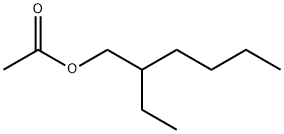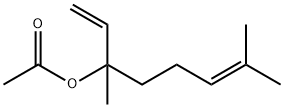2-Ethylhexyl acetate
Synonym(s):2EH Acetate;2-Ethylhexyl acetate;Acetic acid 2-ethylhexyl ester, 3-(Acetoxymethyl)heptane;Acetic acid octyl ester
- CAS NO.:103-09-3
- Empirical Formula: C10H20O2
- Molecular Weight: 172.26
- MDL number: MFCD00027249
- EINECS: 203-079-1
- SAFETY DATA SHEET (SDS)
- Update Date: 2025-03-14 08:59:19

What is 2-Ethylhexyl acetate?
Description
Octyl acetate (octyl ethanoate, acetate C-8, or caprylyl acetate), occurs in many autumn fruits, including apples and pears. You can find it as well in other fruits, from kumquats to oranges, and even in whole wheat bread and beer. Food processing companies make octyl acetate synthetically and use it either to impart a citrus flavor or in combination with other compounds to make artificial apple, peach, pear, and strawberry flavors.
Chemical properties
clear colorless liquid
The Uses of 2-Ethylhexyl acetate
Solvent for nitrocellulose, some resins, waxes, and oils.
What are the applications of Application
2-Ethylhexyl acetate is a solvent used for proteomics research
Definition
ChEBI: An acetate ester that is hexyl acetate substituted by an ethyl group at position 2.
Synthesis Reference(s)
Synthetic Communications, 20, p. 125, 1990 DOI: 10.1080/00397919008054623
Tetrahedron Letters, 23, p. 5407, 1982 DOI: 10.1016/0040-4039(82)80142-1
General Description
A water-white liquid. Insoluble in water and is less dense than water. Flash point 180°F. Used as a solvent and in perfumes. Liquid or vapors may irritate skin and eyes. Vapors have a fruity, pleasant odor.
Air & Water Reactions
Insoluble in water.
Reactivity Profile
2-Ethylhexyl acetate is an ester. Esters react with acids to liberate heat along with alcohols and acids. Strong oxidizing acids may cause a vigorous reaction that is sufficiently exothermic to ignite the reaction products. Heat is also generated by the interaction of esters with caustic solutions. Flammable hydrogen is generated by mixing esters with alkali metals and hydrides. Contact with strong oxidizers may cause vigorous reaction [USCG, 1999].
Health Hazard
Prolonged skin contact may cause irritation.
Fire Hazard
Special Hazards of Combustion Products: Irritating vapors and toxic gases, such as carbon monoxide, may be formed when involved in fire.
Flammability and Explosibility
Non flammable
Safety Profile
Moderately toxic by ingestion. Askin and eye irritant. Flammable when exposed to heat orflame; can react with oxidizing materials. To fight fire, usefoam, CO2, dry chemical. When heated to decompositionit emits acrid smoke and irritating fumes.
Properties of 2-Ethylhexyl acetate
| Melting point: | −92 °C(lit.) |
| Boiling point: | 199 °C(lit.) |
| Density | 0.87 g/mL at 25 °C(lit.) |
| vapor pressure | 0.28 hPa (20 °C) |
| refractive index | n |
| Flash point: | 185 °F |
| storage temp. | Store below +30°C. |
| solubility | water: slightly soluble0.0039 g/L |
| form | Liquid |
| color | Clear colorless |
| Odor | at 10.00 % in dipropylene glycol. earthy herbal humus undergrowth |
| explosive limit | 0.76-8.14%(V) |
| Water Solubility | 3.9mg/L at 20℃ |
| Merck | 14,6763 |
| JECFA Number | 130 |
| BRN | 1758321 |
| CAS DataBase Reference | 103-09-3(CAS DataBase Reference) |
| NIST Chemistry Reference | Acetic acid, 2-ethylhexyl ester(103-09-3) |
| EPA Substance Registry System | Acetic acid, 2-ethylhexyl ester (103-09-3) |
Safety information for 2-Ethylhexyl acetate
| Signal word | Warning |
| Pictogram(s) |
 Exclamation Mark Irritant GHS07 |
| GHS Hazard Statements |
H315:Skin corrosion/irritation |
| Precautionary Statement Codes |
P264:Wash hands thoroughly after handling. P264:Wash skin thouroughly after handling. P280:Wear protective gloves/protective clothing/eye protection/face protection. P302+P352:IF ON SKIN: wash with plenty of soap and water. P332+P313:IF SKIN irritation occurs: Get medical advice/attention. |
Computed Descriptors for 2-Ethylhexyl acetate
| InChIKey | WOYWLLHHWAMFCB-UHFFFAOYSA-N |
2-Ethylhexyl acetate manufacturer
JSK Chemicals
New Products
Methyl (R)-1-Boc-4,4-difluoropyrrolidine-2-carboxylate 2,2-Difluoropropylamine hydrochloride tert-butyl 3-bromoazetidine-1-carboxylate (R)-1-Boc-3-hydroxypyrrolidine DIFLUOROACETIC ANHYDRIDE 2,2-Difluoropropionic acid Diallylamine, 99% Calcium hydroxide, 95% Aluminum oxide, basic 2-Bromophenylacetonitrile, 97% L-tert-Leucine,97% N-Hydroxy-2-methylpropanimidamide 4-(3,4-Dichlorophenyl)-3,4-Dihydro-N-Methyl-1-(2H)-Naphthalenimine (Schiff Base) 2-AMINO-3,5-DIBROMO BENZALDEHYDE [ADBA] L-Glutamic Acid Dimethyl Ester Hcl 10-Methoxy-5H-dibenz[b,f]azepine 5-Cyanophthalide N, N-Carbonyldiimidazole (CDI) Dibenzoyl Peroxide Titanium Dioxide 2-(Methylthio) Benzonitrile Sodium Acetate Anhydrous Allopurinol 1,5-DibromopentaneRelated products of tetrahydrofuran








You may like
-
 2-ETHYL HEXYL ACETATE 99%View Details
2-ETHYL HEXYL ACETATE 99%View Details -
 2-Ethylhexyl acetate 99%View Details
2-Ethylhexyl acetate 99%View Details
103-09-3 -
 103-09-3 2-Ethylhexyl acetate, 99% 99%View Details
103-09-3 2-Ethylhexyl acetate, 99% 99%View Details
103-09-3 -
 2-Ethyl hexyl acetate, puriss CAS 103-09-3View Details
2-Ethyl hexyl acetate, puriss CAS 103-09-3View Details
103-09-3 -
 2-Ethylhexyl Acetate CAS 103-09-3View Details
2-Ethylhexyl Acetate CAS 103-09-3View Details
103-09-3 -
 2-Ethylhexyl acetate CAS 103-09-3View Details
2-Ethylhexyl acetate CAS 103-09-3View Details
103-09-3 -
 2-Ethylhexyl acetate CAS 103-09-3View Details
2-Ethylhexyl acetate CAS 103-09-3View Details
103-09-3 -
 609-15-4View Details
609-15-4View Details
609-15-4
